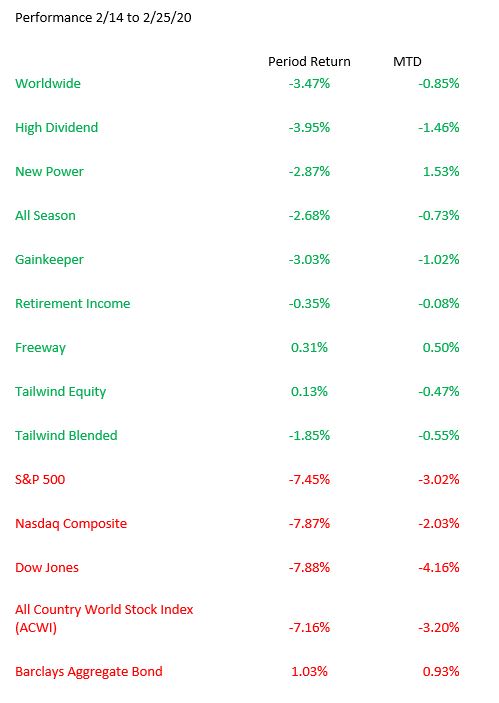What Does Risk Management Look Like When Markets Fail?
I used to watch a lot of Star Trek in my teen days. Maybe it was an escape of sorts; To go where no man has gone before! Captain Kirk was awesome. Occasionally, the starship Enterprise would get hammered by alien “torpedoes” and Kirk would just take it in stride, bouncing around in his captain’s chair for a minute, no emotion, no screaming, no fear. Finally, he would calmly say, “Scotty, damage report please”. This morning I asked our own Scotty (John Burkholder) to run a performance report on our investment strategies from the top of the market 2/14 through yesterday’s close which should serve as a very short-term bottom. I was pleased to see our risk controls working quite well during the market’s mini-crash of the last 7 trading days.
Risk Management in Real-Time
These are the unofficial results of our various investment strategies from 2/14 through the close of 2/25 (yesterday). This is just a quick look at performance using a sampling of real accounts over the last 11 days. The point is to show you what a risk-managed investment strategy does when the markets experience rounds of high volatility. The big unanswerable question is how far will the market fall from here. Is this the bottom of this correction or is it the beginning of our next bear market? I can honestly make a case either way and many can. But I won’t because our system follows the evidence and eliminates guessing (aka gambling). Anyway, here are the results of our investment strategies (in Green) versus various market indices (in Red)

As always, investors make judgments based on what they think will happen to some degree in the future. These assessments are murky, and they only get more unclear as we try to guess into the distant future. We can also look backward at current trends to help guide our allocations but again, if we look too far back, we can find our judgment is skewed. Beyond trends, we can look at valuations as a guide as well. From this perspective, we can do some reasonable forecasting. As we have said many times in the last few months, the US stock and bond markets will not produce the types of returns we have seen in the past (from here). We are projecting less than 4{1de7caaf0b891e8de3ff5bef940389bb3ad66cfa642e6e11bdb96925e6e15654} total returns for a portfolio of US stock and US bonds in any combination for the next 3-5 years. That number may be high in the end. This is how you will survive and thrive in the next market cycle.
- Smart investors will fully embrace risk management now and avoid the temptation to chase yesterday’s winners like large-cap technology stocks.
- Smart investors will build and manage an unconventional portfolio that includes trading strategies, alternatives, commodities (like gold and silver), income streams, and growth, both domestic and international.
- Smart investors will dynamically allocate assets according to current trends.
- Smart investors will pay attention to their current income, spending behavior versus current assets always returns, and real inflation to stay solvent and cash flow positive.
We work with our clients to make them “Smart” investors.
Thank you, Scotty! Back to fighting the aliens.
Captain Sam Jones

